SUZUKI SWIFT 2000 1.G Transmission Service Workshop Manual
Manufacturer: SUZUKI, Model Year: 2000, Model line: SWIFT, Model: SUZUKI SWIFT 2000 1.GPages: 447, PDF Size: 10.54 MB
Page 121 of 447
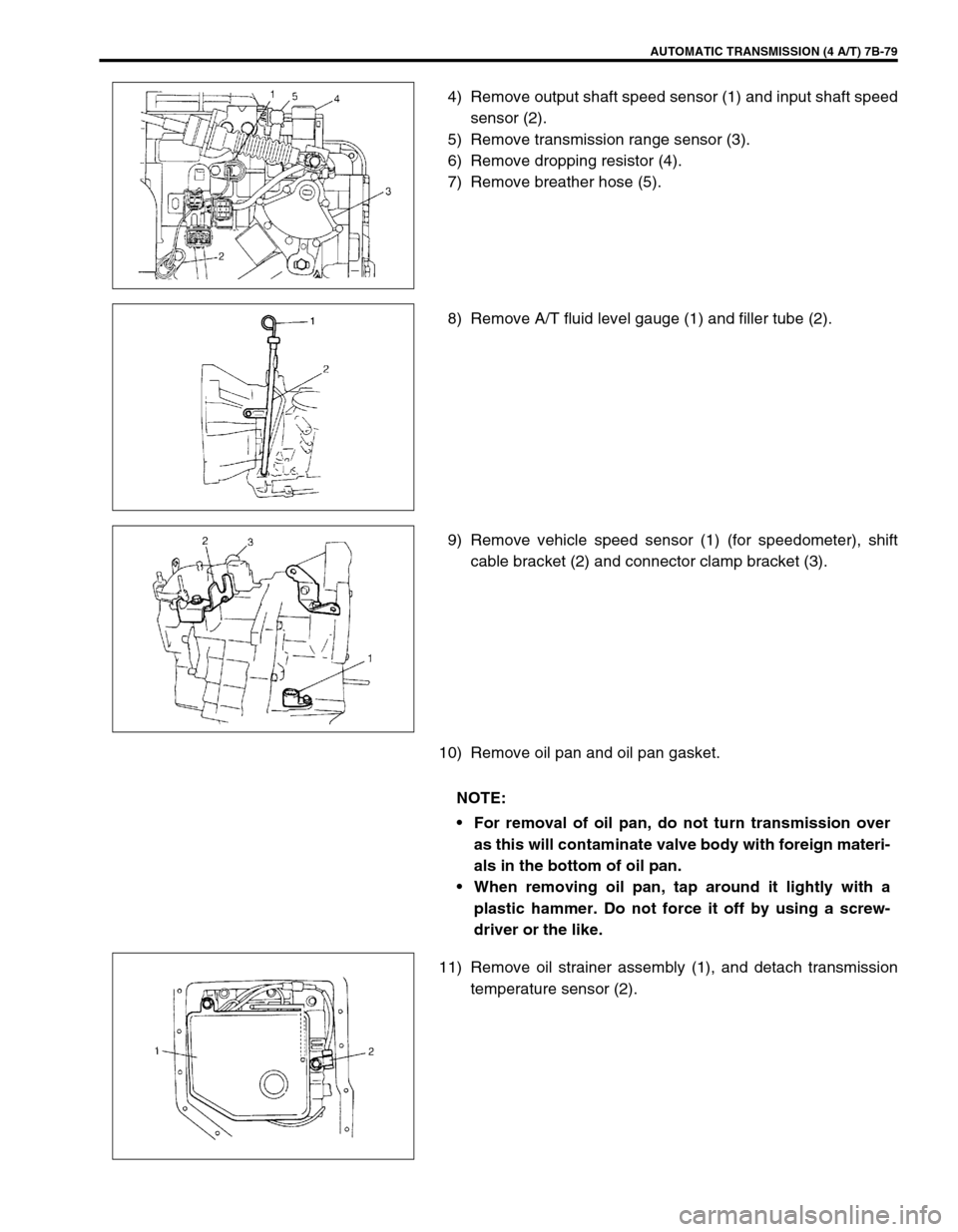
AUTOMATIC TRANSMISSION (4 A/T) 7B-79
4) Remove output shaft speed sensor (1) and input shaft speed
sensor (2).
5) Remove transmission range sensor (3).
6) Remove dropping resistor (4).
7) Remove breather hose (5).
8) Remove A/T fluid level gauge (1) and filler tube (2).
9) Remove vehicle speed sensor (1) (for speedometer), shift
cable bracket (2) and connector clamp bracket (3).
10) Remove oil pan and oil pan gasket.
11) Remove oil strainer assembly (1), and detach transmission
temperature sensor (2).
NOTE:
For removal of oil pan, do not turn transmission over
as this will contaminate valve body with foreign materi-
als in the bottom of oil pan.
When removing oil pan, tap around it lightly with a
plastic hammer. Do not force it off by using a screw-
driver or the like.
Page 122 of 447
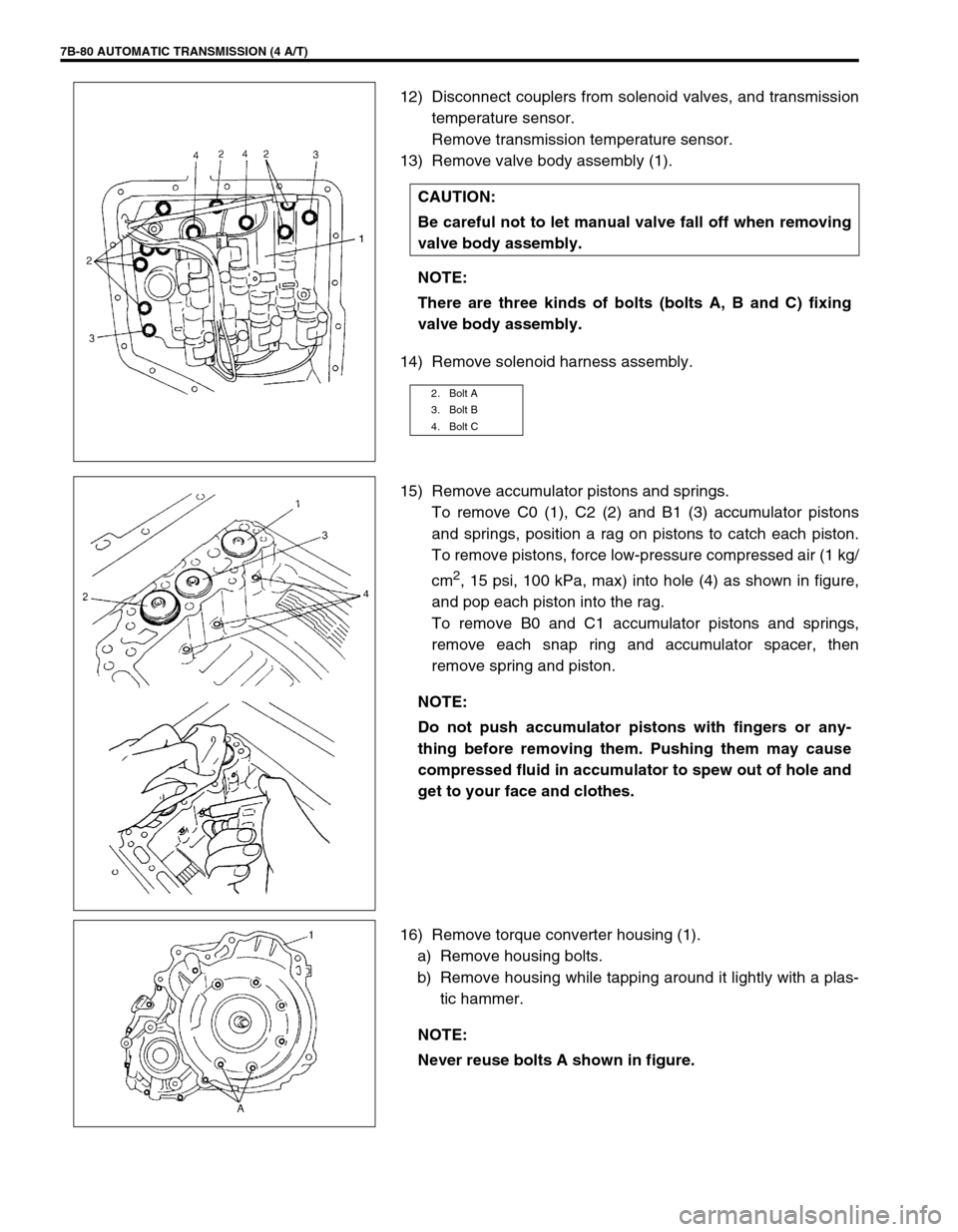
7B-80 AUTOMATIC TRANSMISSION (4 A/T)
12) Disconnect couplers from solenoid valves, and transmission
temperature sensor.
Remove transmission temperature sensor.
13) Remove valve body assembly (1).
14) Remove solenoid harness assembly.
15) Remove accumulator pistons and springs.
To remove C0 (1), C2 (2) and B1 (3) accumulator pistons
and springs, position a rag on pistons to catch each piston.
To remove pistons, force low-pressure compressed air (1 kg/
cm
2, 15 psi, 100 kPa, max) into hole (4) as shown in figure,
and pop each piston into the rag.
To remove B0 and C1 accumulator pistons and springs,
remove each snap ring and accumulator spacer, then
remove spring and piston.
16) Remove torque converter housing (1).
a) Remove housing bolts.
b) Remove housing while tapping around it lightly with a plas-
tic hammer. CAUTION:
Be careful not to let manual valve fall off when removing
valve body assembly.
NOTE:
There are three kinds of bolts (bolts A, B and C) fixing
valve body assembly.
2. Bolt A
3. Bolt B
4. Bolt C
NOTE:
Do not push accumulator pistons with fingers or any-
thing before removing them. Pushing them may cause
compressed fluid in accumulator to spew out of hole and
get to your face and clothes.
NOTE:
Never reuse bolts A shown in figure.
Page 123 of 447
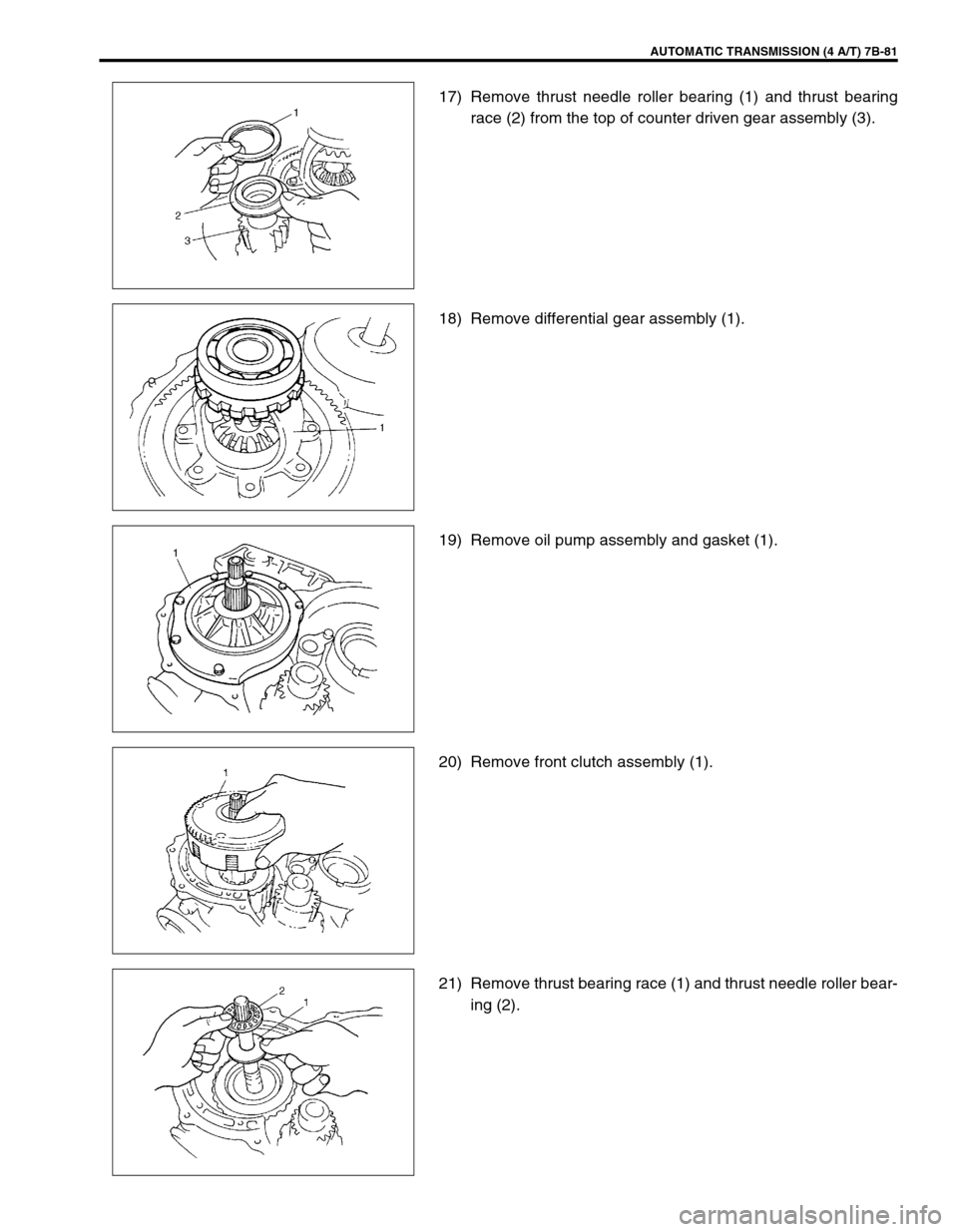
AUTOMATIC TRANSMISSION (4 A/T) 7B-81
17) Remove thrust needle roller bearing (1) and thrust bearing
race (2) from the top of counter driven gear assembly (3).
18) Remove differential gear assembly (1).
19) Remove oil pump assembly and gasket (1).
20) Remove front clutch assembly (1).
21) Remove thrust bearing race (1) and thrust needle roller bear-
ing (2).
Page 124 of 447
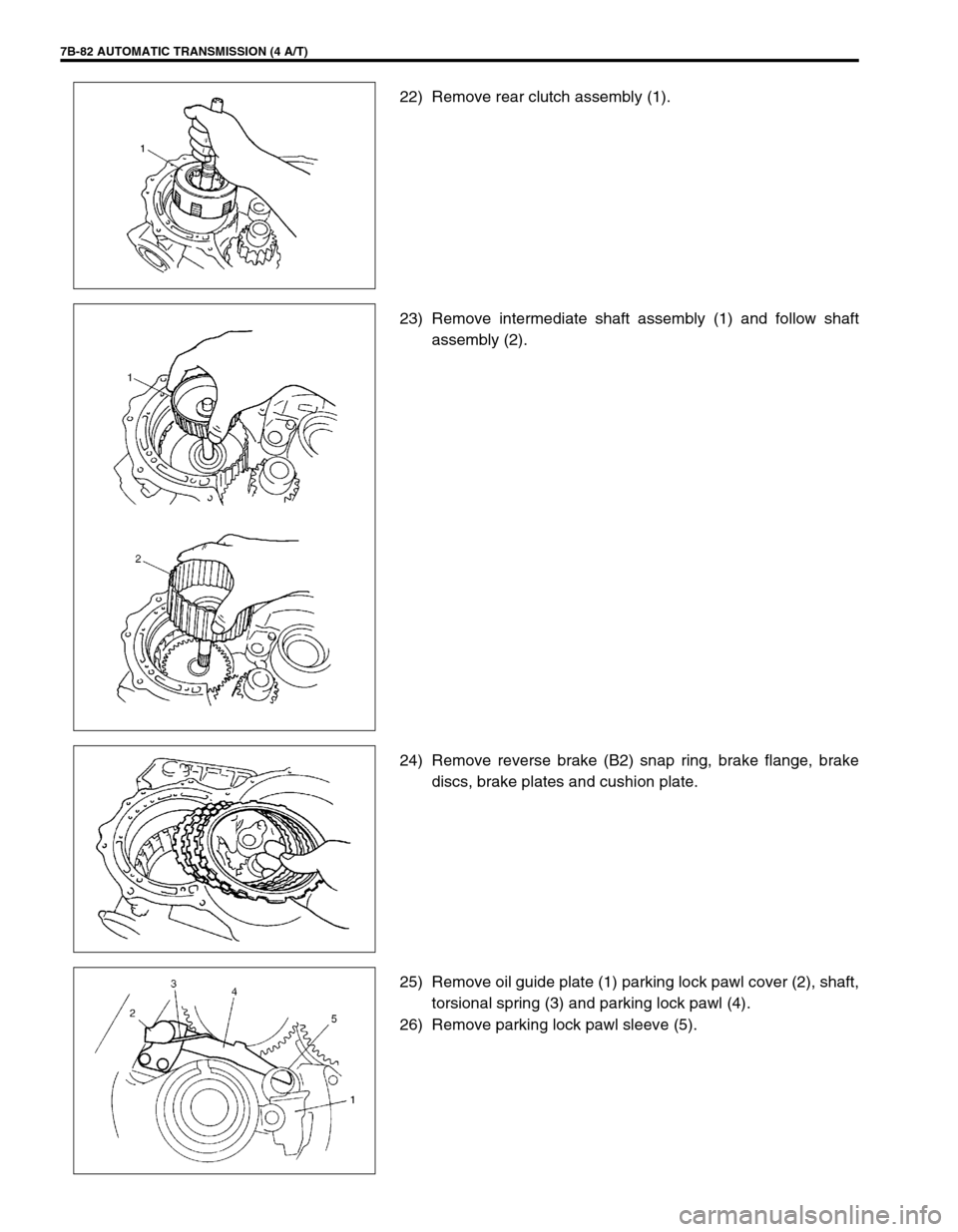
7B-82 AUTOMATIC TRANSMISSION (4 A/T)
22) Remove rear clutch assembly (1).
23) Remove intermediate shaft assembly (1) and follow shaft
assembly (2).
24) Remove reverse brake (B2) snap ring, brake flange, brake
discs, brake plates and cushion plate.
25) Remove oil guide plate (1) parking lock pawl cover (2), shaft,
torsional spring (3) and parking lock pawl (4).
26) Remove parking lock pawl sleeve (5).
Page 125 of 447

AUTOMATIC TRANSMISSION (4 A/T) 7B-83
27) Remove counter driven gear assembly (1) and thrust needle
roller bearing (2).
28) Remove control shift lever (1), nuts (2), washer (3) from
manual shift shaft (4).
29) Remove detent spring (1).
30) Remove manual shift shaft (1) with parking lock rod (2), and
washer (3) from transmission case.
Page 126 of 447
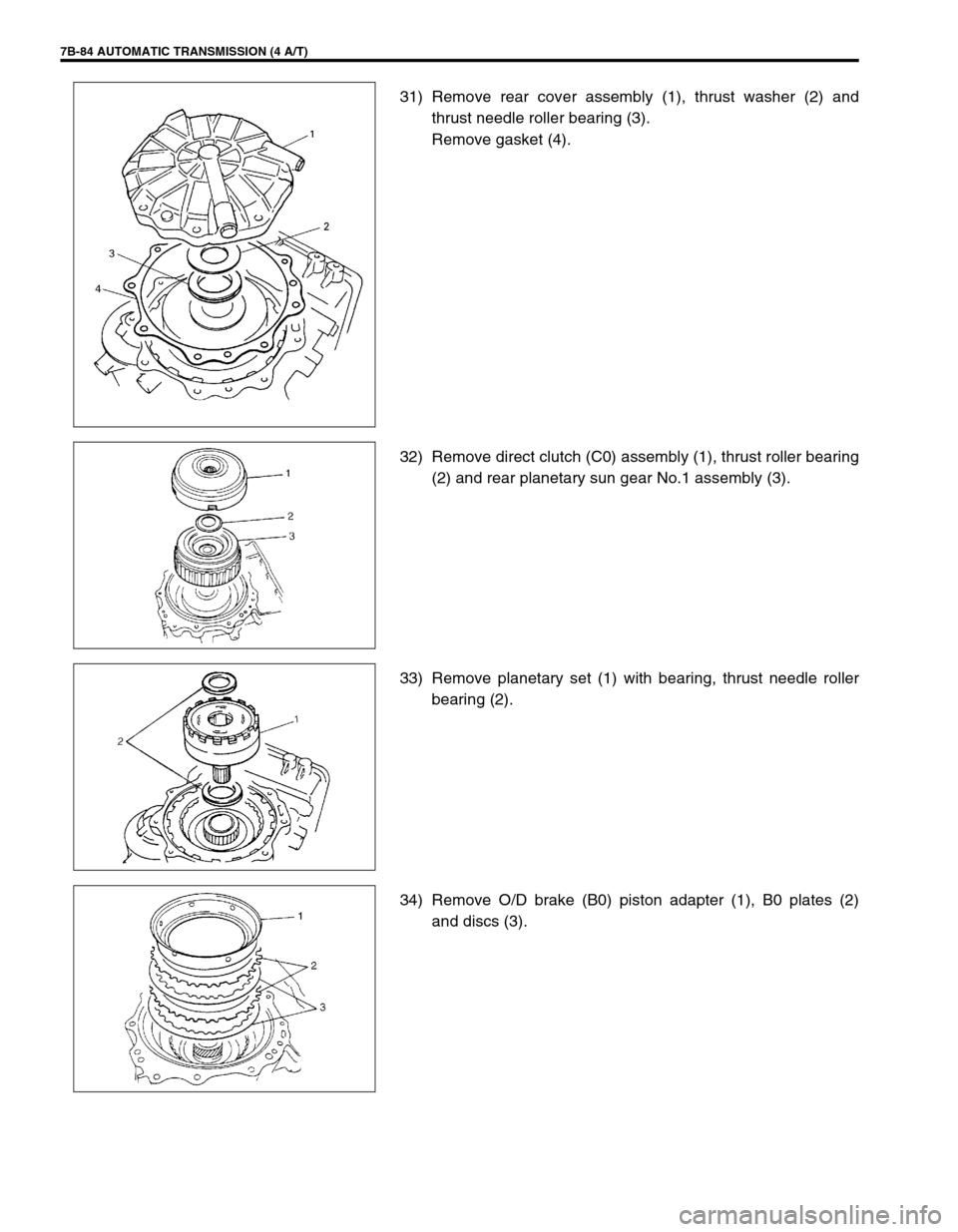
7B-84 AUTOMATIC TRANSMISSION (4 A/T)
31) Remove rear cover assembly (1), thrust washer (2) and
thrust needle roller bearing (3).
Remove gasket (4).
32) Remove direct clutch (C0) assembly (1), thrust roller bearing
(2) and rear planetary sun gear No.1 assembly (3).
33) Remove planetary set (1) with bearing, thrust needle roller
bearing (2).
34) Remove O/D brake (B0) piston adapter (1), B0 plates (2)
and discs (3).
Page 127 of 447

AUTOMATIC TRANSMISSION (4 A/T) 7B-85
35) Remove planetary sun gear No.2 (1) and thrust needle roller
bearing (2).
36) Remove snap ring, then remove brake flange and disc.
37) Remove snap ring, then remove brake discs and plates (B1
brake).
38) Remove snap ring (1), then O/D brake return spring seat (2),
return spring (3) and spring retainer (4).
39) Remove snap ring (1) then remove 1st & 2nd brake piston
return spring subassembly (2) and 1st & 2nd brake piston
(3).
To remove 1st & 2nd brake piston, force low-pressure com-
pressed air (1 kg/cm
2, 15 psi, 100 kPa, max) into hole (5)
shown in figure and pop out 1st & 2nd brake piston into a
rag.
4. Air gun
Page 128 of 447

7B-86 AUTOMATIC TRANSMISSION (4 A/T)
40) Remove counter drive gear (1).
41) Use hydraulic press (8) and special tool to compress wave
spring (4), then remove snap ring (1).
Special tool
(A) : 09926-96040
42) Remove reverse brake piston seat (3), wave spring (4) and
reverse brake piston (5).
To remove reverse brake piston, force low-pressure com-
press air (1 kg/cm
2, 15 psi, 100 kPa, max) into hole (7)
shown in figure, and pop out piston into a rag.
NOTE:
Do not compress wave spring more than necessary.
Do not reuse snap ring (1).
2. Flat end rod or the like
6. Air gun
Page 129 of 447
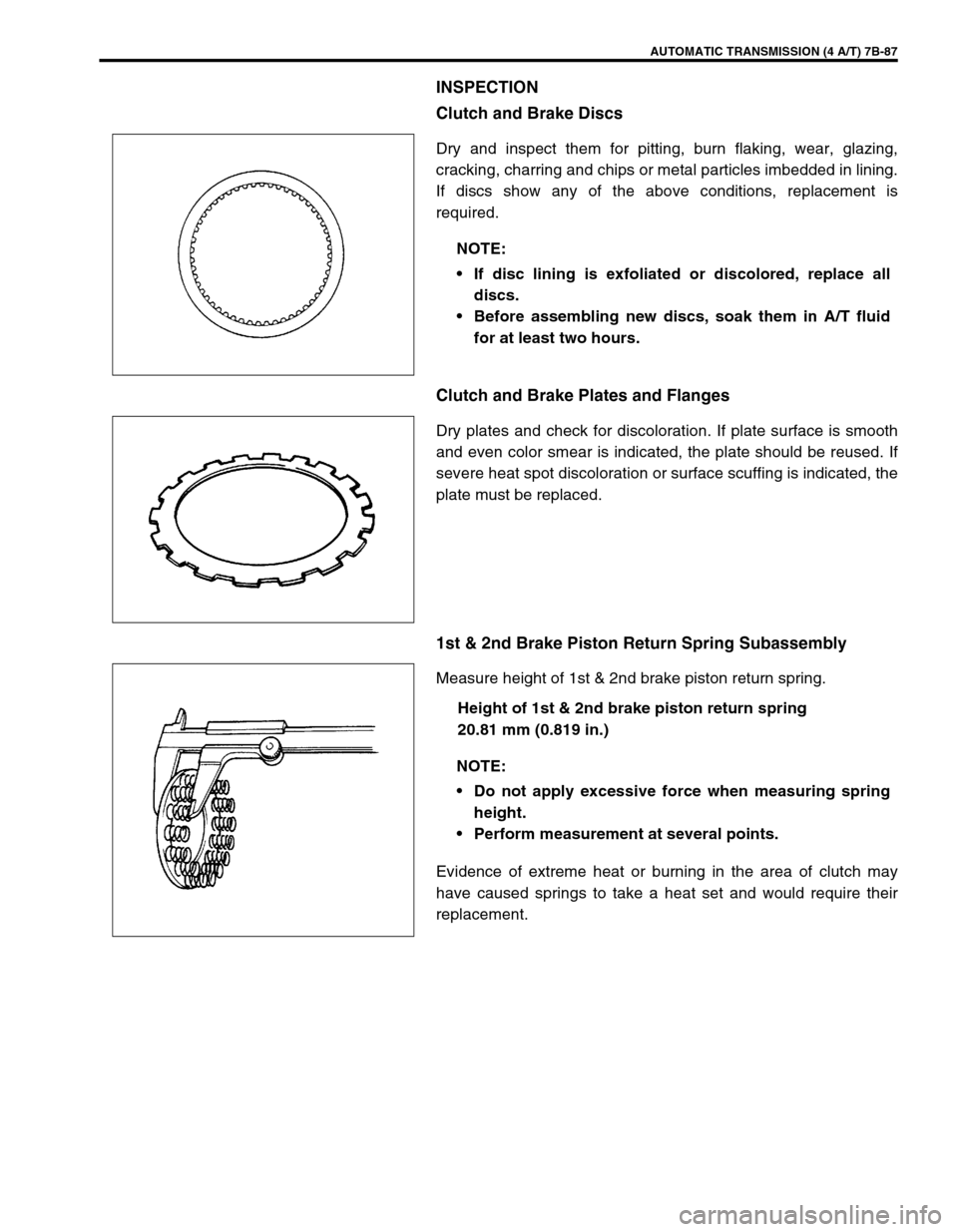
AUTOMATIC TRANSMISSION (4 A/T) 7B-87
INSPECTION
Clutch and Brake Discs
Dry and inspect them for pitting, burn flaking, wear, glazing,
cracking, charring and chips or metal particles imbedded in lining.
If discs show any of the above conditions, replacement is
required.
Clutch and Brake Plates and Flanges
Dry plates and check for discoloration. If plate surface is smooth
and even color smear is indicated, the plate should be reused. If
severe heat spot discoloration or surface scuffing is indicated, the
plate must be replaced.
1st & 2nd Brake Piston Return Spring Subassembly
Measure height of 1st & 2nd brake piston return spring.
Height of 1st & 2nd brake piston return spring
20.81 mm (0.819 in.)
Evidence of extreme heat or burning in the area of clutch may
have caused springs to take a heat set and would require their
replacement.NOTE:
If disc lining is exfoliated or discolored, replace all
discs.
Before assembling new discs, soak them in A/T fluid
for at least two hours.
NOTE:
Do not apply excessive force when measuring spring
height.
Perform measurement at several points.
Page 130 of 447
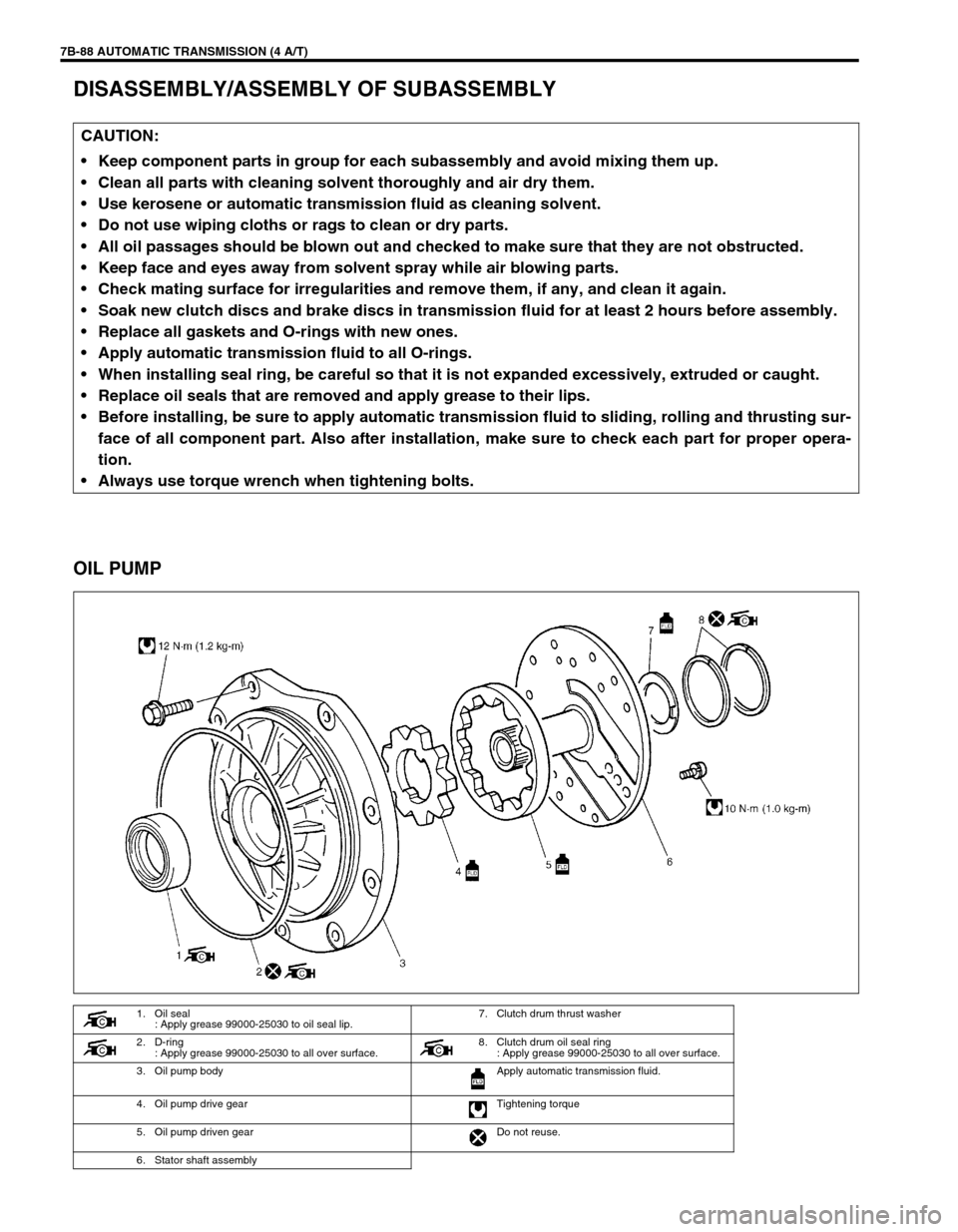
7B-88 AUTOMATIC TRANSMISSION (4 A/T)
DISASSEMBLY/ASSEMBLY OF SUBASSEMBLY
OIL PUMP
CAUTION:
Keep component parts in group for each subassembly and avoid mixing them up.
Clean all parts with cleaning solvent thoroughly and air dry them.
Use kerosene or automatic transmission fluid as cleaning solvent.
Do not use wiping cloths or rags to clean or dry parts.
All oil passages should be blown out and checked to make sure that they are not obstructed.
Keep face and eyes away from solvent spray while air blowing parts.
Check mating surface for irregularities and remove them, if any, and clean it again.
Soak new clutch discs and brake discs in transmission fluid for at least 2 hours before assembly.
Replace all gaskets and O-rings with new ones.
Apply automatic transmission fluid to all O-rings.
When installing seal ring, be careful so that it is not expanded excessively, extruded or caught.
Replace oil seals that are removed and apply grease to their lips.
Before installing, be sure to apply automatic transmission fluid to sliding, rolling and thrusting sur-
face of all component part. Also after installation, make sure to check each part for proper opera-
tion.
Always use torque wrench when tightening bolts.
1. Oil seal
: Apply grease 99000-25030 to oil seal lip.7. Clutch drum thrust washer
2. D-ring
: Apply grease 99000-25030 to all over surface. 8. Clutch drum oil seal ring
: Apply grease 99000-25030 to all over surface.
3. Oil pump body Apply automatic transmission fluid.
4. Oil pump drive gear Tightening torque
5. Oil pump driven gear Do not reuse.
6. Stator shaft assembly